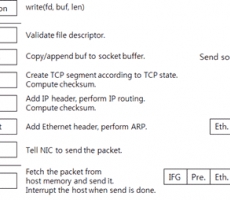-
Read More

Understanding TCP/IP Network Stack & Writing Network Apps
Written by Hyeongyeop Kim on 06/09/2017 We cannot imagine Internet service without TCP/IP. All Internet services we have developed and used at NHN are based on a solid basis, TCP/IP. Understanding how data is transferred via the network will help you to improve performance through tuning, troubleshooting, or introduction to a new technology. This article will describe the overall operation scheme of the network stack based on data flow and control flow in Linux OS and the hardware layer. Key Characteristics of TCP/IP How should I design a network protocol to transmit data quickly while keeping the data order without any data loss? TCP/IP has been designed with this consideration. The following are the key characteristics of TCP/IP required to understand the concept of the stack. TCP and IP ... -
Read MoreNo Image
Understanding Vert.x Architecture - Part I: Inside Vert.x. Comparison with Node.js
Written by Seongmin Woo on 06/14/2017 Vert.x is a server framework that is rapidly arising. Each server framework claims its strong points are high performance with a variety of protocols supported. Vert.x takes a step forward from that. Vert.x considers the environment of establishing and operating the server network environment. In other words, Vert.x includes careful consideration in producing several 'server process DAEMONs' that run on the clustering environment, as well as producing one server process DAEMON. Therefore, it is important to review Vert.x: which network environment it considers as well as how it delivers high performance. So, I think it will be valuable to pay sufficient time examining Vert.x structure. Philosophy of Vert.x Vert.x is a project affected by Node.js. Like N... -
Read More

Understanding Vert.x Architecture - Part II
Written by Jaehong Kim on 06/16/2017 Previous blog article covered Vert.x, a Java application framework which provides noticeable performance advantage over competing technologies and features multi programming language support. The previous article has explained us about the philosophy of Vert.x, performance comparison with Node.js, internal structure of Vert.x, and many more. Today, I would like to continue this conversation and talk more about Vert.x architecture. Considerations Used to Develop Vert.x Polyglot is the feature making Vert.x stand out from other server frameworks. In the past, server frameworks could not support multiple languages. Supporting several languages does more than expand the range of users. More important thing is that services using different languages in a dist... -
Read More

Become a Jave GC Expert Series 4 : MaxClients in Apache and its effect on Tomcat during Full GC
Written by Dongsoon Choi on 06/23/2017 This is the fourth article in the series of "Become a Java GC Expert". In the first issue Understanding Java Garbage Collection we have learned about the processes for different GC algorithms, about how GC works, what Young and Old Generation is, what you should know about the 5 types of GC in the new JDK 7, and what the performance implications are for each of these GC types. In the second article How to Monitor Java Garbage Collection we have explained how JVM actually runs the Garbage Collection in the real time, how we can monitor GC, and which tools we can use to make this process faster and more effective. In the third article How to Tune Java Garbage Collection we have shown some of the best options based on real cases as our examples that you c... -
Read More

Become a Jave GC Expert Series 5 : The Principles of Java Application Performance Tuning
Written by Se Hoon Park on 06/30/2017 This is the fifth article in the series of "Become a Java GC Expert". In the first issue Understanding Java Garbage Collection we have learned about the processes for different GC algorithms, about how GC works, what Young and Old Generation is, what you should know about the 5 types of GC in the new JDK 7, and what the performance implications are for each of these GC types. In the second article How to Monitor Java Garbage Collection we have explained how JVM actually runs the Garbage Collection in the real time, how we can monitor GC, and which tools we can use to make this process faster and more effective. In the third article How to Tune Java Garbage Collection we have shown some of the best options based on real cases as our examples that you can...



